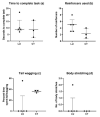A Case Study on the Behavioural Effect of Positive Reinforcement Training in a Novel Task Participation Test in Göttingen Mini Pigs
- PMID: 34072458
- PMCID: PMC8229723
- DOI: 10.3390/ani11061610
A Case Study on the Behavioural Effect of Positive Reinforcement Training in a Novel Task Participation Test in Göttingen Mini Pigs
Abstract
In laboratory animal research, many procedures will be stressful for the animals, as they are forced to participate. Training animals to cooperate using clicker training (CT) or luring (LU) may reduce stress levels, and thereby increase animal welfare. In zoo animals, aquarium animals, and pets, CT is used to train animals to cooperate during medical procedures, whereas in experimental research, LU seem to be the preferred training method. This descriptive case study aims to present the behaviour of CT and LU pigs in a potentially fear-evoking behavioural test-the novel task participation test-in which the pigs walked a short runway on a novel walking surface. All eight pigs voluntarily participated, and only one LU pig showed body stretching combined with lack of tail wagging indicating reduced welfare. All CT pigs and one LU pig displayed tail wagging during the test, indicating a positive mental state. Hence, training pigs to cooperate during experimental procedures resulted in a smooth completion of the task with no signs of fear or anxiety in seven out of eight animals. We suggest that training laboratory pigs prior to experimental procedures or tests should be done to ensure low stress levels.
Keywords: clicker training; laboratory pigs; positive reinforcement training; welfare.
Conflict of interest statement
The authors declare no conflict of interest.
Figures

Similar articles
-
A Positive-Reinforcement Training Regimen for Refined Sample Collection in Laboratory Pigs.Animals (Basel). 2025 Feb 7;15(4):471. doi: 10.3390/ani15040471. Animals (Basel). 2025. PMID: 40002952 Free PMC article.
-
Blood Sampling in Göttingen Minipigs-A Case Study of Two Standard Methods and Clicker Training as a Restraint-Free Alternative.Animals (Basel). 2025 Feb 1;15(3):407. doi: 10.3390/ani15030407. Animals (Basel). 2025. PMID: 39943177 Free PMC article.
-
Transition of Farm Pigs to Research Pigs using a Designated Checklist followed by Initiation of Clicker Training - a Refinement Initiative.J Vis Exp. 2021 Aug 21;(174). doi: 10.3791/62099. J Vis Exp. 2021. PMID: 34487115
-
Requirements for the welfare of baboons and pigs used in animal-to-animal xenotransplantation experiments.Aust Vet J. 2009 Oct;87(10):421-6. doi: 10.1111/j.1751-0813.2009.00486.x. Aust Vet J. 2009. PMID: 19796166 Review.
-
Tail biting in pigs.Vet J. 2001 Nov;162(3):196-210. doi: 10.1053/tvjl.2001.0605. Vet J. 2001. PMID: 11681870 Review.
Cited by
-
Behavioral responses to artificial insemination and the effect of positive reinforcement training.PLoS One. 2024 Oct 10;19(10):e0310537. doi: 10.1371/journal.pone.0310537. eCollection 2024. PLoS One. 2024. PMID: 39388492 Free PMC article.
-
Practical implementation and impact of the 4R principles in ethnopharmacology: Pursuing a more humane approach to research.Front Pharmacol. 2025 Mar 28;16:1543316. doi: 10.3389/fphar.2025.1543316. eCollection 2025. Front Pharmacol. 2025. PMID: 40223937 Free PMC article. Review.
-
Clicker Training in Minipigs to Reduce Stress during Blood Collection-An Example of Applied Refinement.Animals (Basel). 2024 Sep 30;14(19):2819. doi: 10.3390/ani14192819. Animals (Basel). 2024. PMID: 39409768 Free PMC article.
-
Clicker Training as an Applied Refinement Measure in Chickens.Animals (Basel). 2023 Dec 13;13(24):3836. doi: 10.3390/ani13243836. Animals (Basel). 2023. PMID: 38136873 Free PMC article.
-
A Positive-Reinforcement Training Regimen for Refined Sample Collection in Laboratory Pigs.Animals (Basel). 2025 Feb 7;15(4):471. doi: 10.3390/ani15040471. Animals (Basel). 2025. PMID: 40002952 Free PMC article.
References
-
- Olsson I.A.S., Nevison C.M., Patterson-Kane E.G., Sherwin C.M., Van de Weerd H.A., Wurbel H. Understanding behaviour: The relevance of ethological approaches in laboratory animal science. Appl. Anim. Behav. Sci. 2003;81:245–264. doi: 10.1016/S0168-1591(02)00285-X. - DOI
LinkOut - more resources
Full Text Sources
Miscellaneous

